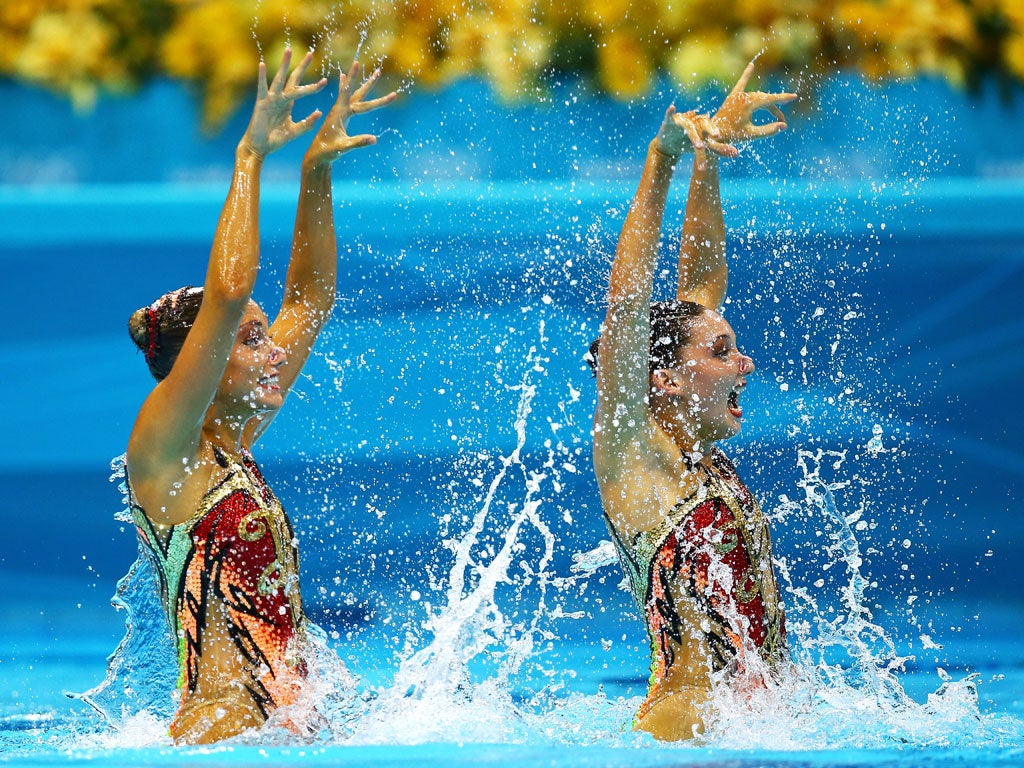In at the deep end
Synchronised swimming is a mystery to most. Rebecca Gonsalves took the plunge

As a spectator, the Olympic disciplines which have long been the most fascinating are those which appear to be executed without effort – no matter how much logic, and gravity, would attest to the contrary.
The obvious grist that accompanies a sprint or long distance run leaves me feeling spent just watching from the sofa – while the elegance of contracting muscles and swinging limbs of the more balletic sports is somehow energising (rictus grins aside).
Synchronised swimming, then, appears to offer the best, or perhaps worst, of both worlds. It may be unbelievably hard work, but the secret is not to show it to the judges or spectators – all while wearing a spangly costume, make-up that would make a drag queen's look subtle and, who could forget, an oh-so-glamorous nose-clip.
On the eve of the first stage of the team finals, Louise Woolley, the 27-year-old development coach who helped to train current captain Jenna Randall and led the British team to the World Championships in 2009 is ready to put me through my paces in the pool at her parent's Beckenham home.
First though, I must slip in to a suitably glitzy creation and am handed a diamanté-strewn orange and black velvet costume made by Woolley's mother for a previous performance. Luckily, I don't have to slick back my hair with a paste made from cooking gelatine and hot water (marks are deducted for hairs out of place) or paint my face with waterproof make-up.
Soon I am in the water warming up before the lesson, delivered from the poolside by Woolley, begins. First comes a "back layout", a seemingly simple position where I must keep my whole body horizontal, floating on the surface. My legs must be held tightly together, toes pointed and chin pushed towards the ceiling.
Simple? I spoke too soon. Every time I look to check my toes are pointing in the right direction, my bottom heads towards the floor of the pool. Woolley is nothing if not a determined coach though and after a few attempts which see me straighten out somewhat, I am told to first bend one leg at the knee to achieve the "sailboat" position before straightening it in the air – toes pointed of course – in what is known as ballet leg. Working through the positions I attempt handstands, both in the shallow end and slightly deeper water. Here I try my hands at sculls – small hand movements which keep one buoyant when upside down underwater.
From a handstand I must kick my legs apart to achieve a split leg position. A gold medallist would be able to perform this with their legs out of water to the thigh.
Woolley advises me to attempt to stick mine out a few inches above my ankles. Still I struggle. It seems synchro is about more than just spangly swimming costumes and winning smiles – it's about iron muscles and a will of steel.
I must slip into a suitably glitzy creation. I am handed a diamante-strewn orange and black velvet costume
Synchronised swimming has only been part of the Olympic roster since the 1984 Los Angeles games and though it has long been dominated by the Russian Federation, Team GB has recently edged its way up the rankings. In 2007, Great Britain ranked 22nd in the world, while earlier this year at a qualifier held in London they reached 9th position. Later today the team will take part in the first leg of their quest for the final – the technical routine in which eight swimmers perform a set sequence of eight elements – before completing the free routine in the final on Friday. It is one of only two Olympic sports for female-only competitors (the other is rhythmic gymnastics).
Subscribe to Independent Premium to bookmark this article
Want to bookmark your favourite articles and stories to read or reference later? Start your Independent Premium subscription today.

Join our commenting forum
Join thought-provoking conversations, follow other Independent readers and see their replies